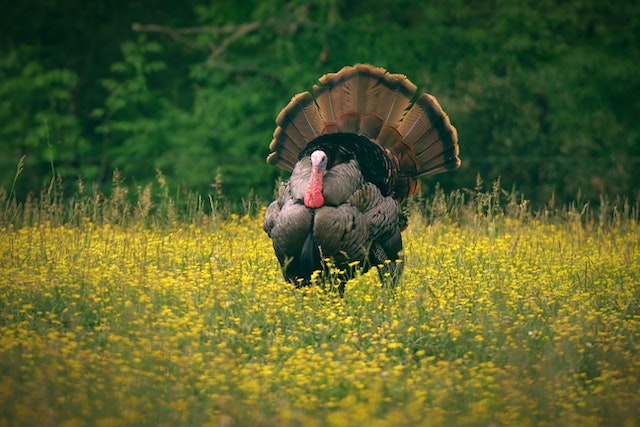Can Wild Turkeys Fly? Debunking Common Myths

Often seen roaming fields or wooded areas, wild turkeys are a common sight in many parts of the United States. These large, ground-dwelling birds may appear quite heavy and you might wonder, can wild turkeys fly? Despite their size, wild turkeys are in fact capable of flight.
Wild turkeys can fly at speeds of up to 55 mph for short distances, typically limited to about a mile. Their strong wings enable them to take flight suddenly, which is essential for escaping potential predators. Wild turkeys prefer to roost in trees at night, a behavior that further supports their capability to fly.
It’s crucial to differentiate between wild turkeys and their domestic counterparts. While both species are related, domestic turkeys have been selectively bred for size and weight, often rendering them unable to fly. Wild turkeys possess the ability to fly, showcasing their adaptability and resilience in the wild.
Wild Turkey 101: A Brief Overview
Wild turkeys are fascinating creatures, often seen roaming the forests and grasslands throughout North America. Although they’re commonly thought of as large, ground-dwelling birds, wild turkeys possess some unexpected abilities – including the capacity for flight.
To understand more about these intriguing birds, let’s delve into the basics of wild turkey biology, behavior, and habitat.
First and foremost, it’s essential to know that wild turkeys belong to the Meleagrididae family, with two primary subspecies: the Eastern wild turkey (Meleagris gallopavo silvestris) and the Osceola or Florida wild turkey (Meleagris gallopavo osceola).
These subspecies differ mainly in their geographic distribution and slight variations in physical appearance.
Some key characteristics of wild turkeys include:
- Size: Wild turkeys are large birds, standing around 3-4 feet tall.
- Weight: They can weigh anywhere between 5-24 pounds, depending on their age and sex.
- Color: Wild turkeys’ plumage varies from coppery to greenish, with iridescent feathers around their neck and chest.
Turkeys have distinctive behaviors that are worth taking note of:
- They’re omnivorous, dining on a wide range of food sources.
- Dominant males engage in elaborate mating displays, fanning their tail feathers and puffing up their bodies to attract females.
- Wild turkeys are known to roost in trees during the nighttime, offering some protection from predators.
In terms of habitat, these birds can be found in a broad array of environments, from dense forests and grasslands to wetlands and urban areas. However, their preferred dwelling is usually a mixture of woodland and open, grassy spaces.
When it comes to the question of whether wild turkeys can fly, many might be surprised to learn that they indeed possess this ability.
Although they spend the majority of their time on the ground, wild turkeys have strong, powerful wings that enable them to take to the air. In fact, they can fly at speeds of up to 55 miles per hour for short distances, typically around one mile or less.
Flight for wild turkeys serves as both a means of evading predators and reaching their nightly roosting sites.
While domestic turkeys are often unable to fly due to their heavier weight and selective breeding, their wild counterparts have retained this impressive skill.
It’s just one of the many fascinating aspects of wild turkey biology and behavior that makes them a remarkable species to study and appreciate.
See also: What Do Wild Turkeys Eat?
Taking Flight: The Aerial Capabilities of Wild Turkeys
Contrary to popular belief, wild turkeys possess the ability to fly. Despite their somewhat ungainly appearance, these birds have been gifted with impressive aerial capabilities.
In this section, we’ll delve into the details of how they accomplish this feat and the circumstances under which they choose to take flight.
Wild turkeys rely on their relatively strong wings to propel them into the air. These birds have a wingspan that ranges from 4 to 5 feet and their wing surface area is larger in comparison to their body weight. This allows them to achieve swift, albeit short, flights.
A wild turkey’s flight is generally low, swift, and close to the ground, covering distances usually up to 1 mile at speeds of 50 to 55 mph.
| Wingspan | Flight Distance | Speed |
|---|---|---|
| 4-5 feet | Up to 1 mile | 50-55mph |
It’s essential to note that flight plays a crucial role in a wild turkey’s ability to evade predators. When confronted, they don’t hesitate to take flight, showcasing their remarkable aerial agility and effortlessness, contrary to their domesticated counterparts who cannot fly due to selective breeding for increased meat production.
Their flights usually occur:
- During roosting, where they fly up into trees to sleep
- When escaping from predators, like foxes, bobcats, and feral dogs
- In search of food resources when the need arises, often in open, grassy fields or edge habitats like gardens and agricultural lands
Wild turkeys achieve flight through the following steps:
- With a brief running start, they forcefully flap their wings
- They rapidly increase wing beats, providing the necessary lift
- They gracefully soar close to the ground, maintaining their speed by steering with their tail and alternating between flapping and gliding
Despite being capable flyers, wild turkeys spend a significant amount of their time on the ground, primarily foraging for food. They prefer to run or walk when traversing short distances or when approaching danger.
In summary, the aerial capabilities of wild turkeys should not be underestimated. These birds have developed a functional adaptation to survive and thrive in their habitats, demonstrating their remarkable resilience and agility.
Conclusion
So, can wild turkeys fly? It’s time to set the record straight. Contrary to popular belief and despite their cumbersome appearance, wild turkeys do possess the ability to fly. In fact, they’re rather agile and speedy in the air. Here is some key information we learned in the previous sections:
- Wild turkey flight abilities: Wild turkeys can fly at speeds of up to 55 miles per hour, usually covering distances of one mile or less.
- Difference between wild and domestic turkeys: Domestic turkeys, unlike their wild counterparts, cannot fly due to their selectively bred size and weight.
- Reasons for flight: Wild turkeys take to the skies primarily to escape predators and reach their roosting sites at night.
Indeed, it may be surprising for many to learn that these large birds are capable of flying. But nature never ceases to amaze, and wild turkeys are no exception.
In summary, the mystery surrounding the flight abilities of wild turkeys has been unraveled. Now you can confidently share this newfound knowledge with others. So the next time someone asks, “Can wild turkeys fly?”, you’ll be prepared with an informed answer.
| Property | Wild Turkeys | Domestic Turkeys |
|---|---|---|
| Flight ability | Yes | No |
| Maximum flight speed | 55 miles per hour | N/A |
| Typical flight distance | Up to 1 mile | N/A |
Whether it’s dispelling myths, sharing fun facts, or just satisfying curiosity, learning about the wonders of the natural world will never cease to be an enlightening and entertaining endeavor. Wild turkeys serve as just one reminder of the many surprises nature has in store for us.
